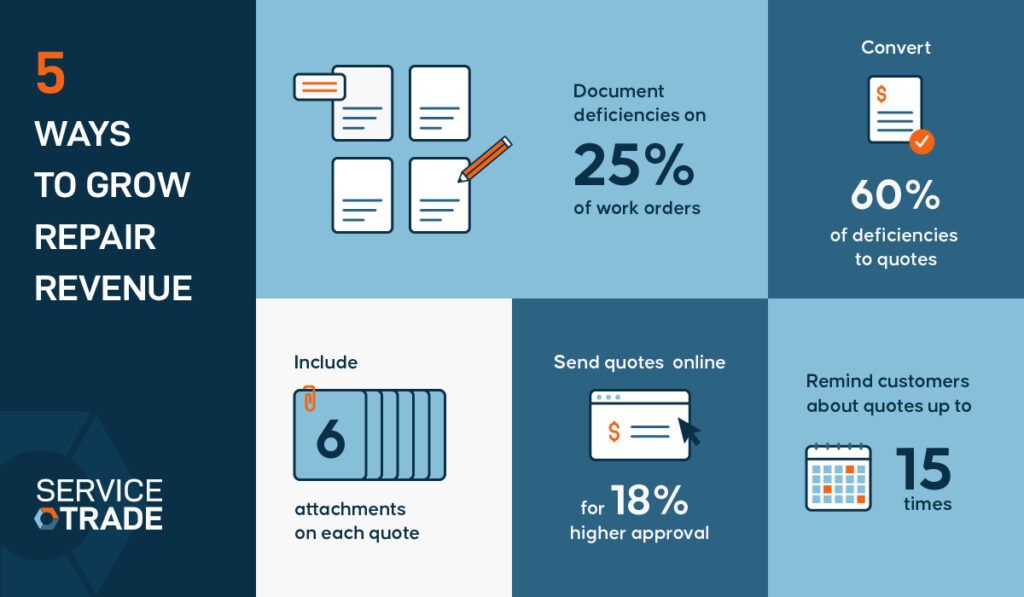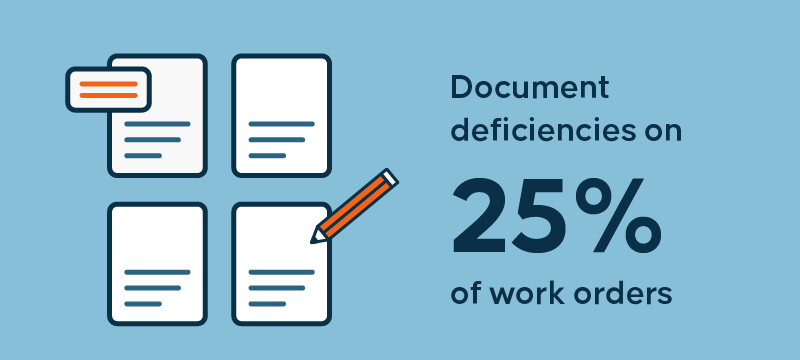The Deficiency Efficiency Guide
5 Steps to Higher Revenue and Safer Facilities

Would you like more high-margin repair jobs on your schedule? How about less liability risk and more satisfied customers? If so, it’s time to take a closer look at your deficiency management processes.
Fire and life safety contractors who don’t prioritize deficiency management or lack the necessary tools are missing out on significant revenue opportunities. And that’s not all. Failing to document all deficiencies, present them compellingly to customers, and efficiently schedule approved repairs puts your business at risk. You could face liability claims or lose your best customers due to overlooked issues. Poor deficiency management is bad for business all around.
On the other hand, data shows that contractors who prioritize deficiency management grow faster, earning 2X more revenue per customer than their lower-performing peers. All while reducing their liability risks and building trust with their customers.
To help you achieve similar success, we’re sharing some data-backed strategies. Convert risk into revenue and deficiencies into dollars with these 5 steps.
1. Identify and Document More Deficiencies
Impactful deficiency management begins in the field with technicians who regularly identify and document deficiencies. We suggest you aim to document deficiencies in at least 25 percent of your work orders. How are your techs performing?

How It Impacts Revenue
Data shows that the contractors who bring in the most high-margin repair revenue record a lot more deficiencies than their lower performing peers. Top performers identify deficiencies on about 25 percent of all work orders, while bottom performers only document deficiencies 10 percent of the time.
How It Mitigates Risk
Thorough inspections are essential for identifying potential issues that could harm your client’s facilities. Failing to document and report these issues can result in claims against your business.
What You’ll Need
- An efficient system for technicians to report deficiencies, ensuring they are documented in a centralized list accessible to the office, so nothing gets lost in the shuffle.
- Training and motivation for technicians to identify and document more deficiencies.
Read: Why You Should Document More Deficiencies (And How To Do It)
2. Capture More Data
Enriching deficiency reports with notes, photos, and videos helps your customers better understand the issues and their severity. Additionally, including media with your repair quotes increases the likelihood of approval.

How It Impacts Revenue
Rich documentation of deficiencies affects revenue in two ways. For one, it shows your thorough work, leading to more loyal and satisfied customers who are willing to pay a premium for your services. It also increases the likelihood that customers will approve repair quotes associated with the deficiency, increasing your high-margin repair work. Data shows that repair quotes with 5-7 rich media attachments are most likely to be approved.
How It Mitigates Risk
Maintaining and providing customers with rich records and documentation of all deficiencies is great backup for disputing a claim. It also helps customers better understand any deficiencies that may put their facility at risk.
What You’ll Need
- Equipment, such as a tablet or smartphone, to capture rich media.
- An efficient method for attaching media to deficiency reports.
- A simple way to share attachments and deficiency reports with customers.
- A record-keeping system that allows for easy retrieval of documents in the event of a claim.
Read: Why Your Deficiency Reports Should Include Images, Video, and More
3. Create And Send More Quotes
Promptly converting deficiencies into repair quotes is crucial for booking repair jobs and earning that revenue. Aim to convert around 60 percent of deficiencies into repair quotes, and send quotes as quickly as possible. Data shows that the sooner you send repair quotes after the inspection, the more likely customers are to approve them.

How It Impacts Revenue
Turning documented deficiencies into repair quotes is essential for generating high-margin repair revenue. The more quotes you issue, the more revenue you can earn. As a benchmark, top-performing contractors convert deficiencies into quotes 60% of the time.
How It Mitigates Risk
Repair quotes add to your paper trail and provide a strong liability defense. In the event of a related claim, you can prove that you identified the deficiency and provided a repair quote. Quoting is also vital for your customers, who rely on following through with repairs to maintain compliance and ensure the safety of their facilities.
What You’ll Need
- An efficient system for staff to receive deficiency reports soon after inspections, ideally on a dedicated list outside the inspection report, so nothing is lost.
- A manual or automated workflow for quickly converting deficiencies into quotes.
- A method like email or a dedicated customer portal for quickly delivering quotes to customers.
- An easy process for customers to accept or decline quotes.
Read: Want to Boost Repair Revenue? Send More Quotes.
4. Follow Up (A Lot)
Amid your customer’s crowded inbox and lengthy to-do list, it’s easy for items like your repair quotes to be overlooked. Data shows that persistent email reminders give your customers the nudge they need to review and respond to your quotes. Automate your communications and aim to send 15 reminders before giving up.

How It Impacts Revenue
Successfully capturing your customers’ attention increases the likelihood of quote approvals, thereby boosting repair revenue. Data indicates that approval rates continue to rise with up to 15 reminders.
How It Mitigates Risk
Persistent reminders increase the chances of clients approving repairs that ensure compliance and safety for their facilities. Records of these reminders also provide strong evidence of due diligence in the event of a liability claim.
What You’ll Need
- An efficient way, like email, to deliver reminders.
- An established follow-up cadence.
- Ideally, a system that can automate reminders.
Read our article: The Key to Boosting Quote Approvals? Follow Up (A Lot).
5. Prioritize the Resulting Repair Work
The final step to boosting your deficiency management performance is to promptly schedule approved repairs. Prioritizing this work not only generates revenue but also demonstrates your reliability and efficiency to customers.

How It Impacts Revenue
Repairs are high-margin work. Fire and life safety contractors who perform best in “pull-through” efficiency (converting deficiencies into repair work) earn an impressive 99% more per customer compared to those in the bottom half.
How It Mitigates Risk
Completing repairs is essential for ensuring your client’s facilities meet code requirements and safeguarding human life and property.
What You’ll Need
- An efficient scheduling system that enables schedulers to identify priority work when scheduling.
- A straightforward method for sharing deficiency and repair documentation with the technician performing the work.
Read our article: How and Why to Prioritize High-Margin Repair Work on Your Schedule
